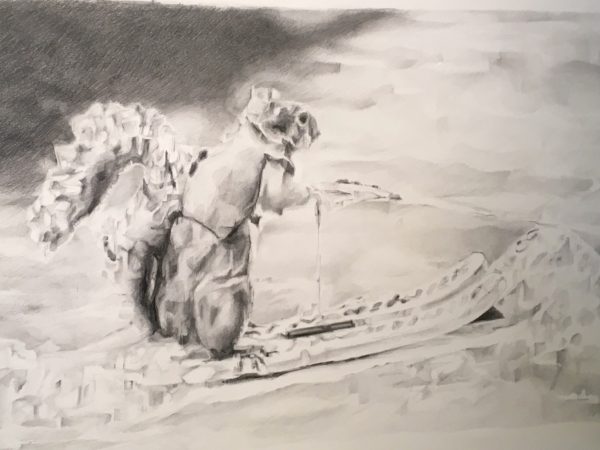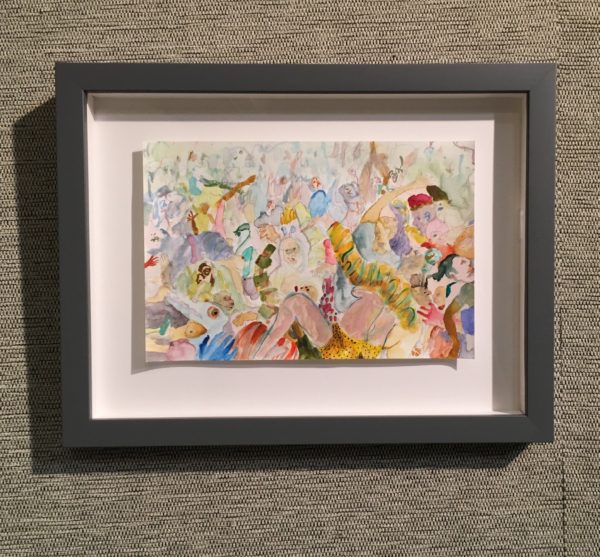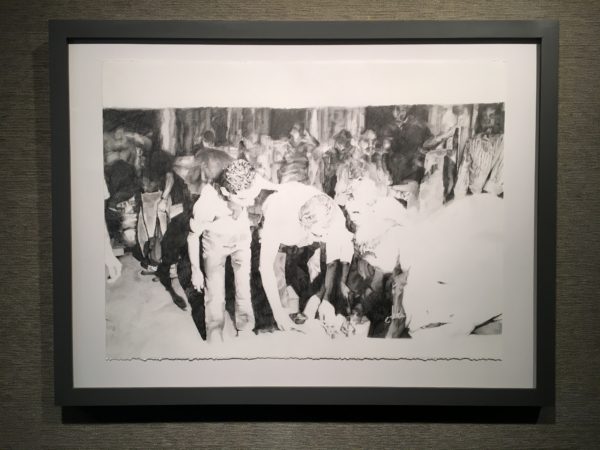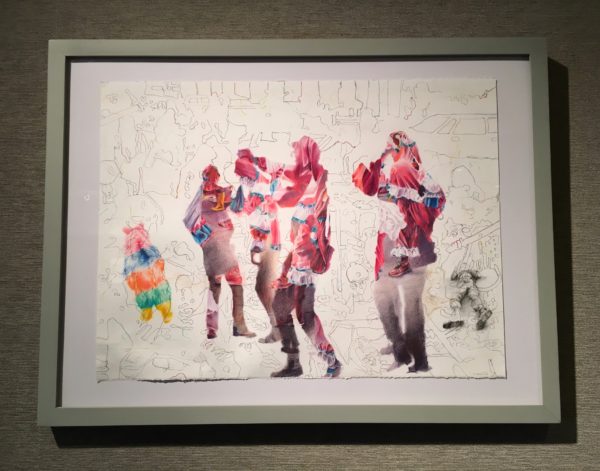Rarely a week goes by that a show or film lands with that feeling that a better iteration exists inside it. Curatorial went too subjective. Joel Murray’s Media Purity leans into this sensation. His sprawling drawings, currently up at the Lillian Bradshaw Gallery at the Dallas Public Library, features a sub-series titled I Want to Be All of These People that I want to be all of the show. Typifying early exhibitions by young artists and ones largely self-curated, Media Purity doesn’t quite do what it claims to. Or if it does, it plays the long game. Pulling from years of work, the show’s progression gives it juice. Digging through the library to get there gives it edge.
Any formal failure on display detracts little from the honorable aims of the artist. So what now? Prompting questions like Who gets a platform?, there’s bravery in an artist entering the crossfire. Should audience evaluation of Media Purity depend more on formal bravery over content? (Are we asking this question these days?) Some intent remains in the ether, but how much by design?
Murray’s day job as an arts educator and professor is palpable. “I really enjoy portraiture and the history of portraiture,” he admits, using figures to build a moral framework for our times, not unlike Marlene Dumas whose ideological vertex of a series Great Men, part of The Absent Museum show, just departed WEILS in Brussels this month. Formally looking back to the ghosting images of Goya and the hubbub of crowds painted by Breugel, Murray’s latest “inclusive parties” take their references seriously, sometimes. Goya’s dual status as the first modern painter and the last of the old masters seems to grant Murray poetic license. Steeped in technique, Murray’s aim is contemporary. His target? Sigh. The news.
Murray’s most succinct summation of News Media’s oblique usefulness is in the trio Anchorperson, Human Faux Human, and Pseudobulbar Affect — three news anchors all caught mid-blooper in fits of laughter that could be confused for agony or orgasm. While the juxtaposition between 628,403 Views and Tahrir Square 2011 highlights noticeable coverage disparity favoring ephemera over world events, Murray’s thematic elbow-drops are less interesting than his detailing and play with light. Media Purity flunks transcending the image hierarchy it indicts because that squirrel is the Edmund Hillary of news-blooper-reel clips.
As fat a target as mainstream media deservedly is, Murray’s satire lacks bite in 2017, but in fairness, many of these works were made in 2015 — simpler times, surely. But Murray is a gentle soul, less concerned with dropping truth bombs than the inclusiveness of identity politics.
Media Purity gets messiest in Muray’s most painstaking work. Triumphant Slurring’s pixilated tire fire and Molotov cocktail-armed protestor are superimposed over a chimp on a scooter. Ukrainian Riot and Philadelphia Clown Parade juxtaposes two scenes: the Mummers New Year’s Parade and the January 1, 2014 protests in Kiev’s Independence Square from the same day. These hybrids, assembled first in Photoshop, then meticulously recreated with pencil as abstracts, demonstrate Murray’s skill set. But, intended jabs at cycles of soundbytes and palate cleansers can get a little foggy, and even invite unintended comparison. At what point does fracturing images obscure intent? Murray’s prioritization and selection of images is both diffusive and investigative, which seems at odds.
Tucked in the back of the back of the Bradshaw Gallery’s low light and consuming carpet, in the artist’s most recent watercolor series I Want to be All of These People, Murray finds an outlet for his political bent brimming with all the magic his previous figurative output hints at.
“I’ve had this overwhelming feeling for the past year. The only way to kind of empathize with someone’s human experience in the fullest way possible is to become that person,” Murray explains.
Push aside incoming images of Buffalo Bill from Silence of the Lambs. Murray whips up a wacky confluence of imagined archetypes who populate our news, gathered in what the artist calls “inclusive parties.” Abandoning pre-existing imagery and working straight from impressions, this dreamscape-y series really gets to glimpsing some soul. Maybe aided by exponentially less hours for completion (10 vs. 200), confidence subs in for exactitude.
Murray knows illustration as an effective means for identifying with others. Negotiating his own upbringing, Murray attempts to embody his polar opposite on the social spectrum, estimating this to be “a very large Caribbean trans person.” It may sound like walking on eggshells — a white male in his 30s attempting relational politics through watercolor — but the effect is total joie de vivre. Nimble, fun and woke, these works don’t resort to the murky pulpit-y language of his previous output.
As the artist explains his relational exercise in the series to me, he preempts some critique by dropping reference to Artforum’s latest summer issue’s cultural appropriation round table. Ranging from easy targets like Katy Perry to Rachel Dolezal in discussion, and reaching little in the way of consensus, Homi Bhabha, a literature professor and Director of the Mahindra Humanities Center at Harvard drops this exonerating nug:
“Appropriation need not only be across gender or color lines. Within the same gender, there can be class appropriations, there can be appropriations for all kinds of other forms of leverage. That doesn’t mean that one political deployment of these tactics is interchangeable with another — each needs to be assessed on its own terms, and they’re far more complicated than the term appropriation allows. We need to ask: Why are you doing this? Why are you choosing to make this citation or juxtaposition?”
Murray knows what he’s doing and why. He teaches it. “When does cultural appropriation become violence towards a group?” he asks. Not here. Though, I am also a white male in my 30s, so to quote an early educational hero, you don’t have to take my word for it.
Media Purity is a ropey show of high and low, one in keeping with the intent of the Bradshaw Gallery space. The library seeks out artists who will workshop across their oeuvre as a means for community engagement. This framework imbues the show with some fearlessness that might not otherwise be evident. Sequentially hung to demonstrate process (if not entirely organically), works like Try Festive Moment, Outstanding Collection and I Want to be All of These People for a Half-day display satisfying maturation. Less concerned about what he himself has to say, these drawings speak for themselves.









